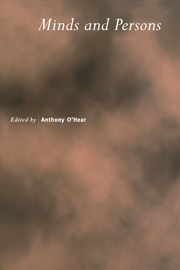Book contents
- Frontmatter
- Contents
- Preface
- Notes on Contributors
- Perceptual, Reflective and Affective Consciousness as Existence?
- The Domain of Folk Psychology
- Minds, Persons and the Unthinkable
- Moderately Massive Modularity
- A Theory of Phenomenal Concepts
- Free Will and the Burden of Proof
- Materialism and the First Person
- Language, Belief and Human Beings
- Human Minds
- Non-Personal Minds
- Personal Agency
- Mental Substances
- Mind and Illusion
- Index
Perceptual, Reflective and Affective Consciousness as Existence?
Published online by Cambridge University Press: 04 August 2010
- Frontmatter
- Contents
- Preface
- Notes on Contributors
- Perceptual, Reflective and Affective Consciousness as Existence?
- The Domain of Folk Psychology
- Minds, Persons and the Unthinkable
- Moderately Massive Modularity
- A Theory of Phenomenal Concepts
- Free Will and the Burden of Proof
- Materialism and the First Person
- Language, Belief and Human Beings
- Human Minds
- Non-Personal Minds
- Personal Agency
- Mental Substances
- Mind and Illusion
- Index
Summary
Criteria of Adequacy for Analyses of Consciousness
One criterion of an adequate analysis of the nature of consciousness has to do with its three parts, sides or elements. These are seeing and the like, thinking and the like, and desiring and the like. The seeming natures of the perceptual, reflective and affective parts or whatever of consciousness are different despite similarity. An adequate analysis of consciousness, even if general, will preserve the differences. It will pass the test of what you can call differential phenomenology.
A second criterion is making consciousness something that exists in the ordinary way, a reality. Certainly we suppose it to be such. Yours came into existence at some stage of your embryonic development and goes out of existence and comes back into existence when you fall into and come out of dreamless sleep. What is it for anything to exist in the ordinary way? To my mind it is for the thing to be physical or of the same sort as the physical. What it is to be of the same sort as the physical, and hence what a tolerant naturalism or physicalism comes to, will be clearer later.
As for physical things themselves, they come in two lots. (1) Things that take up space and time and are perceived by all, or maybe all the experts—this truistic point about their being public will be relevant to much that follows.
- Type
- Chapter
- Information
- Minds and Persons , pp. 1 - 24Publisher: Cambridge University PressPrint publication year: 2003

